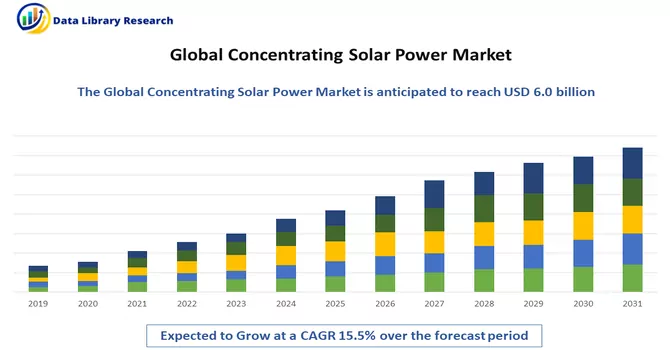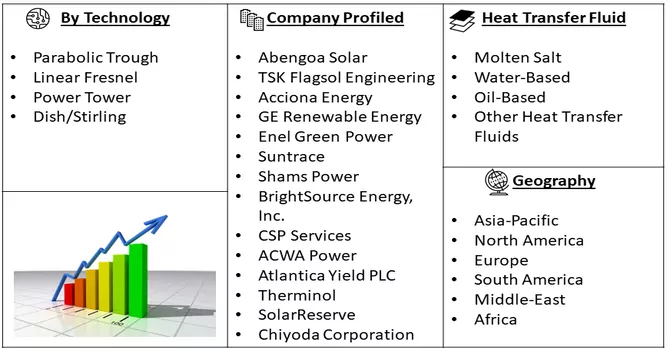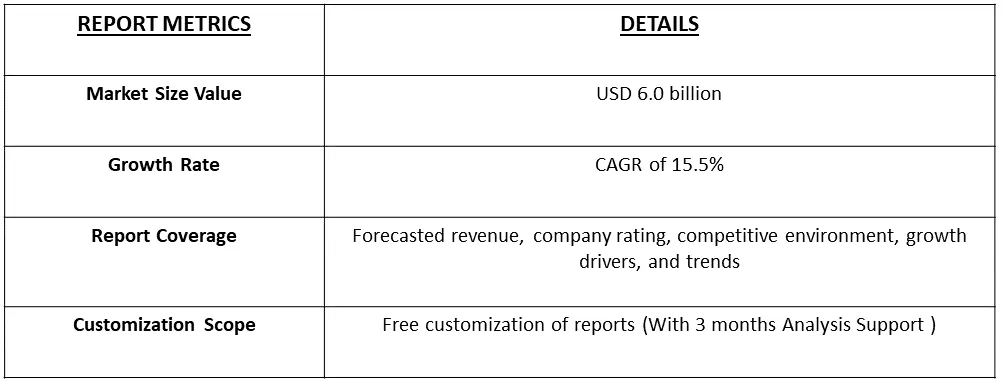The global Concentrating Solar Power (CSP) market is estimated to have reached USD 6.0 billion in 2022, with expectations of a robust compound annual growth rate (CAGR) of 15.5% throughout the forecast period from 2023 to 2030.

Get Complete Analysis Of The Report - Download Free Sample PDF
CSP, as a renewable energy technology, utilizes mirrors or lenses to concentrate sunlight onto a receiver, generating high-temperature heat for various applications, particularly the production of electricity. Diverging from traditional photovoltaic (PV) solar panels that directly convert sunlight into electricity, CSP systems operate by converting solar energy into thermal energy.
Several key factors are influencing the growth and adoption of CSP technology. The inherent advantages and appeal of CSP in the realm of renewable energy are underscored by its capacity to harness sunlight for electricity generation, presenting a clean and sustainable energy source. In response to escalating global concerns about climate change and the imperative for environmental sustainability, there is an increasing demand for technologies that diminish reliance on fossil fuels and contribute to a low-carbon energy matrix. Notably, CSP plays a pivotal role in addressing energy security concerns by offering a reliable and diversified energy source. Its unique capability to generate electricity during periods of high demand, combined with energy storage capabilities, fortifies the resilience of the power grid and diminishes dependence on conventional fossil fuels. This aligns with broader global initiatives to transition towards more sustainable and resilient energy systems.
Market Segmentation: The Concentrated Solar Power Market is Segmented by Technology (Parabolic Trough, Linear Fresnel, Power Tower, And Dish/Stirling), Heat Transfer Fluid (Molten Salt, Water-Based, Oil-Based, and Other Heat Transfer Fluids), and Geography (North America, Europe, Asia-Pacific, South America, and The Middle East and Africa). The Market Size and Forecasts for the Concentrated Solar Power Market are provided in terms of Installed Capacity (MW) for all the Above Segments.

For Detailed Market Segmentation - Download Free Sample PDF
The CSP market is experiencing a trend of continuous global capacity expansion. New projects are being planned and commissioned across different regions, indicating a growing interest in CSP as a reliable and sustainable source of renewable energy. Energy storage solutions are gaining prominence in CSP projects. The integration of advanced energy storage technologies, such as molten salt or thermal storage, enhances the dispatchability of CSP-generated power, allowing for electricity production during periods of low or no sunlight. Ongoing research and development efforts are driving technological advancements in CSP systems. Improvements in mirror designs, receiver technologies, and overall system efficiency are contributing to higher performance and reducing the levelized cost of electricity (LCOE) for CSP projects. These trends collectively underscore the dynamic nature of the CSP market, with a focus on technological innovation, cost-effectiveness, and sustainable deployment practices.
Market Drivers:
Growing Global Installed Capacity and Increased Focus on Energy Storage Integration
The CSP market has witnessed an increase in global installed capacity, with new projects being commissioned in various regions. As countries strive to diversify their energy mix and reduce reliance on traditional fossil fuels, CSP is gaining attention as a viable and scalable renewable energy solution. Also, energy storage is becoming a crucial aspect of CSP projects. Integrating thermal energy storage systems, such as molten salt storage, allows CSP plants to store excess energy generated during sunny periods for later use. This trend addresses the intermittent nature of solar energy and contributes to providing dispatchable power. Thus, these market trends are expected to drive the growth of the studied market over the forecast period.
Increasing Awareness of CSP Benefits
The growing awareness of the benefits of Concentrating Solar Power (CSP) technology reflects a broader recognition of its potential contributions to sustainable energy solutions. CSP technology provides reliable and dispatchable power, addressing one of the challenges associated with certain renewable energy sources, such as solar photovoltaics and wind. The ability to store thermal energy enables CSP plants to produce electricity even during periods of low or no sunlight, contributing to grid stability and meeting energy demand when needed.
Moreover, governments, businesses, and communities increasingly prioritize sustainability goals. CSP technology aligns with these goals by offering a clean and renewable energy solution. The sustainable nature of CSP resonates with entities seeking to reduce their carbon footprint, adhere to environmental regulations, and demonstrate a commitment to responsible energy practices. Many governments around the world are implementing incentives and supportive policies to encourage the adoption of renewable energy technologies, including CSP. Incentives such as feed-in tariffs, tax credits, and subsidies create a favourable environment for investment in CSP projects, driving awareness and uptake. Thus, the growing awareness of the benefits of CSP technology is driven by its capacity to provide reliable and dispatchable power, reduce greenhouse gas emissions, enhance energy security, contribute to economic development, align with sustainability goals, and receive support from policies and research initiatives. This awareness underscores the pivotal role that CSP can play in the broader transition to a more sustainable and resilient energy future.
Market Restraints:
High Initial Cost of Investment
One significant challenge facing the widespread adoption of Concentrating Solar Power (CSP) technology is the considerable upfront investment required for project construction and deployment. The specialized components essential for CSP systems, such as mirrors, receivers, and thermal storage systems, contribute to higher initial capital costs. This financial barrier may limit the broader acceptance and implementation of CSP technology, particularly when compared to other more established and cost-competitive forms of renewable energy. It's worth noting that ongoing efforts in research and development, economies of scale, and technological advancements aim to address this challenge, striving to reduce overall costs and enhance the economic viability of CSP projects in the long term.
The global supply chain disruptions caused by lockdowns and restrictions during the pandemic could have affected the production and delivery of key components for CSP systems. Delays in the supply chain might have impacted project timelines. Restrictions on movement and labour shortages, especially in the construction sector, could have led to delays in the development and construction of CSP projects. Social distancing measures and health protocols may have slowed down on-site activities. Changes in electricity demand patterns during lockdowns and economic uncertainties may have influenced the demand for new CSP projects. Some regions experienced shifts in energy consumption, affecting the business case for certain renewable energy developments.
Segmental Analysis:
Parabolic Trough Segment is Expected to Witness Significant Growth Over the Forecast Period
Parabolic trough technology is a key component of the Concentrated Solar Power (CSP) market, offering a proven and mature approach to harnessing solar energy for electricity generation. This technology utilizes parabolic-shaped mirrors to focus sunlight onto a receiver pipe running along the focal line. The concentrated solar energy heats a working fluid within the receiver, producing steam that drives a turbine connected to a generator, ultimately generating electricity. Parabolic trough systems are known for their efficiency in concentrating sunlight and converting it into thermal energy. Many projects incorporate thermal storage systems, typically using molten salt, allowing to produce electricity even when the sun is not shining. This feature enhances the dispatchability of power. Thus, parabolic trough technology plays a crucial role in the broader Concentrated Solar Power market, offering an efficient and reliable solution for sustainable electricity generation. The market's evolution is influenced by ongoing technological advancements, policy support, and the global commitment to transitioning towards cleaner and more sustainable energy sources. Thus, the segment is expected to witness significant growth over the forecast period.
Molten Salt Segment is Expected to Witness Significant Growth Over the Forecast Period
Molten salt technology is a significant innovation in the Concentrated Solar Power (CSP) market, providing a means of efficiently storing and utilizing thermal energy. In CSP systems, molten salt serves as both a heat transfer fluid and a storage medium, allowing for the capture and storage of solar energy. This technology enhances the dispatchability of CSP-generated power, enabling electricity production even during periods without direct sunlight. Molten salt is employed as a thermal energy storage medium in CSP systems. During periods of high solar radiation, excess thermal energy is stored in the form of heated molten salt. This stored energy can be utilized to generate electricity during periods of low sunlight, providing a continuous and reliable power supply. Thus, molten salt technology is a key enabler in the Concentrated Solar Power market, providing an efficient solution for thermal energy storage. As the demand for sustainable energy solutions grows, CSP technologies incorporating molten salt are poised to play a pivotal role in the global transition to cleaner and more resilient power generation.
North America Region is Expected to Witness Significant Growth Over the Forecast Period
North America has emerged at the forefront of the concentrated solar power market, primarily driven by a heightened awareness of the advantages associated with solar energy. The region's increasing emphasis on transitioning towards clean and sustainable energy sources has significantly bolstered the demand for concentrated solar power. Additionally, substantial investments in the implementation of cutting-edge technologies play a crucial role in propelling the growth of the concentrated solar power market in North America. The collective effect of these factors underscores the region's leadership in advancing the adoption of concentrated solar power solutions. Thus, the region is expected to witness significant growth over the forecast period.

Get Complete Analysis Of The Report - Download Free Sample PDF
The Concentrated Solar Power (CSP) market exhibits a moderate level of fragmentation, featuring numerous local companies vying for market share. These industry players are actively pursuing strategies such as investments, partnerships, and acquisitions & mergers to enhance their market presence. Additionally, companies are allocating resources to the development of advanced products, aiming to stay ahead in the competitive landscape. Competitive pricing is another focal point for these entities as they strive to maintain a strong market position. Some of the prominent players in the global concentrated solar power market include:
Recent Development:
1) February 2023: Vast Solar announced that the Australian Renewable Energy Agency has provided funding of USD 44 million to develop a 30 MW CSP plant in Port Augusta, Australia.
2) February 2023: Engineers India Limited floated a tender, inviting technology licensors and suppliers to develop a new CSP project at an undisclosed location. The company has also announced that companies with functional but non-commercialized CSP technologies can participate in the bidding process.
Q1. What was the Concentrating Solar Power (CSP) Market size in 2022?
As per Data Library Research the global Concentrating Solar Power (CSP) market is estimated to have reached USD 6.0 billion in 2022.
Q2. At what CAGR is the Concentrating Solar Power market projected to grow within the forecast period?
Concentrating Solar Power market is expected to grow at a compound annual growth rate (CAGR) of 15.5% over the forecast period
Q3. What are the factors driving the Concentrating Solar Power market?
Key factors that are driving the growth include the Growing Global Installed Capacity and Increased Focus on Energy Storage Integration and Increasing Awareness of CSP Benefits.
Q4. Which region has the largest share of the Concentrating Solar Power market? What are the largest region's market size and growth rate?
North America has the largest share of the market . For detailed insights on the largest region's market size and growth rate request a sample here
Data Library Research are conducted by industry experts who offer insight on industry structure, market segmentations technology assessment and competitive landscape (CL), and penetration, as well as on emerging trends. Their analysis is based on primary interviews (~ 80%) and secondary research (~ 20%) as well as years of professional expertise in their respective industries. Adding to this, by analysing historical trends and current market positions, our analysts predict where the market will be headed for the next five years. Furthermore, the varying trends of segment & categories geographically presented are also studied and the estimated based on the primary & secondary research.
In this particular report from the supply side Data Library Research has conducted primary surveys (interviews) with the key level executives (VP, CEO’s, Marketing Director, Business Development Manager and SOFT) of the companies that active & prominent as well as the midsized organization
FIGURE 1: DLR RESEARH PROCESS

Extensive primary research was conducted to gain a deeper insight of the market and industry performance. The analysis is based on both primary and secondary research as well as years of professional expertise in the respective industries.
In addition to analysing current and historical trends, our analysts predict where the market is headed over the next five years.
It varies by segment for these categories geographically presented in the list of market tables. Speaking about this particular report we have conducted primary surveys (interviews) with the key level executives (VP, CEO’s, Marketing Director, Business Development Manager and many more) of the major players active in the market.
Secondary ResearchSecondary research was mainly used to collect and identify information useful for the extensive, technical, market-oriented, and Friend’s study of the Global Extra Neutral Alcohol. It was also used to obtain key information about major players, market classification and segmentation according to the industry trends, geographical markets, and developments related to the market and technology perspectives. For this study, analysts have gathered information from various credible sources, such as annual reports, sec filings, journals, white papers, SOFT presentations, and company web sites.
Market Size EstimationBoth, top-down and bottom-up approaches were used to estimate and validate the size of the Global market and to estimate the size of various other dependent submarkets in the overall Extra Neutral Alcohol. The key players in the market were identified through secondary research and their market contributions in the respective geographies were determined through primary and secondary research.
Forecast Model
